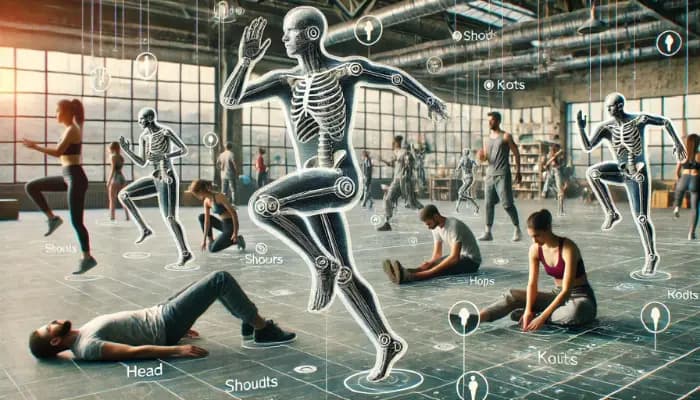Project Overview
Imagine a system that can identify and track human poses instantly, enhancing computer vision technology. This project brings that idea to life using the cutting-edge YOLOv8 model for real-time human pose detection. Human pose detection has become a game-changer, especially in areas like security, health, and entertainment. This project enables real-time tracking of human body positions in both images and videos.
We’ve trained the YOLOv8 model using the COCO dataset, which is widely known for its rich diversity. After training, the model is ready to predict human poses in any photo or video you provide. The project isn’t just about predictions. It also offers visual tools to make the detected poses easy to analyze. Once the model detects a pose in a video, the output is compressed for seamless viewing and sharing. For customization, you can fine tune the model's architecture, training parameters, and input data. This makes the project highly flexible for any specific use case you may have.
Whether you're working on images or videos, this project ensures an efficient and user-friendly experience with human pose detection.
Prerequisites
Before embarking on this project, ensure that you possess the following foundational components:
- A basic and solid understanding of Python programming.
- Google Colab is used for running the code and accessing files easily.
- A Google Drive account is also required for data storage and retrieval.
- The project relies on the powerful YOLO (You Only Look Once) model, which is renowned for its efficiency in object detection and pose estimation. Installing the Ultralytics package is crucial to getting started.
- COCO dataset is used for training the model.
- FFmpeg is used for video compression. So familiarity with using this tool is required.
- Libraries like NumPy, OpenCV, and Matplotlib are used for image processing, video handling, and data visualization within the project.
Approach
In this project, we use the YOLOv8 model for automatic pose detection. YOLOv8 is used for real-time object detection, such as license plate recognition, and it is optimized for identifying human poses. The project focuses on evaluating how well YOLOv8 detects. We apply image preprocessing techniques such as resizing.
These steps enhance the quality of data and ensure robustness in different conditions. Additionally, we use model detection based on video. After training, we load video data to detect human pose.
The performance of the YOLOv8 model is analyzed with mean Average Precision (mAP). We visualize the results using bounding boxes around the detected pose. It provides a detailed analysis of model performance. This will help optimize the detection process. Also, it provides practical insights for self-driving in the future.
Workflow and Methodology
The overall workflow of this project includes:
- Data Collection: Collecting a dataset of labeled human poses from the COCO dataset is used.
- Data Preprocessing: Preparing the images by resizing. This step improves model generalization and ensures robustness during the training phase.
- Model Design: Implement the YOLOv8 detection model for human pose identification. YOLOv8’s architecture is designed to perform real-time object detection. It will provide high accuracy and speed.
- Training: Training the YOLOv8 model using the prepared training dataset. The model is evaluated with a validation set to fine-tune values and prevent overfitting.
- Evaluation: We test with the unseen dataset to assess its ability to accurately detect poses from human movement. Use mAP (mean Average Precision) is used for performance evaluation.
- Result showcasing: Displaying results with bounding boxes around the detected human pose. We also plot and apply inference to detect human pose in real-time using Gradio.
The methodology involves:
- Data Preprocessing: Preprocessing the collected RGB images by resizing them. It resizes the required input dimensions. It enhances the diversity of training data and prevents overfitting.
- Model Architecture: YOLOv8 is used for real-time object detection like license plate recognition. It is trained to locate and classify cataracts in pose images.
- Metrics: Testing the model with unseen pose images. Using (mAP) that evaluates the model’s performance.
Data Collection
To obtain more accurate results in pose detection we use the COCO dataset which has the labeled images of humans in all possible poses. The COCO dataset is regularly applied in computer vision to solve such tasks as object detection, segmentation, and pose estimation.
Data Preparation
The next thing that is done is the preparation of the data for use in the models. The preparation part helps to make sure that the YOLOv8 model is trained and used for human pose detection.
Steps for Data Preparation:
- Cleaning and Preprocessing: The dataset is scanned to choose only a high quality set of images in order to train it. All mislabeled images or any file containing corrupt data are not included in the training set or test set.
- Annotation: Every picture contains points, that can be named as key points of the human body part such as the head, some parts of the shoulders, knees, etc. These annotations are required for understanding of the Human body structures by this Model.
- Resizing: All the images are resized to 640×640 pixels because YOLOv8 is most effective at this size and input size remains unchanged during training.
